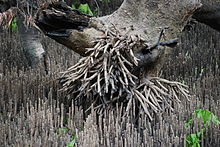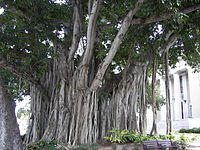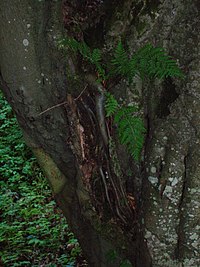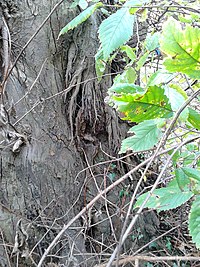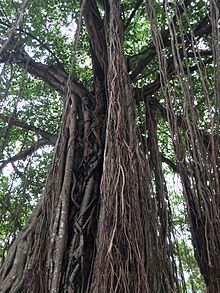83:
91:
27:
58:
260:
41:
72:
428:
220:, the rata tree, sends aerial roots down several sides of the trunk of the host. From these descending roots, horizontal roots grow out to girdle the trunk and fuse with the descending roots. In some cases, the "strangler" outlives the host tree, leaving as its only trace a hollow core in the massive pseudotrunk of the rata.
518:
Aerial roots on houseplants do not serve as much of a purpose as on outdoor plants, as there is no rain indoors and indoor humidity is often low due to A/C and heating systems. However, studies have shown that increasing indoor humidity can result in houseplant aerial roots growing longer in length,
381:
Many other epiphytes - non-parasitic or semi-parasitic plants living on the surface of other plants - have developed cups and scales that gather rainwater or dew. The aerial roots in this case work as regular surface roots. There are also several types of roots, creating a cushion where a high
378:(the white spongy envelope of the aerial roots), are actually totally waterproof, preventing water loss but not allowing any water in. Once reaching and touching a surface, the velamen is not produced in the contact area, allowing the root to absorb water like terrestrial roots.
363:
and not for water absorption. In other cases, they are used mainly for structure, and in order to reach the surface. Many plants rely on the leaf system for gathering the water into pockets, or onto scales. These roots function as terrestrial roots do.
202:
of another tree. Their roots grow down and around the stem of the host, their growth accelerating once the ground has been reached. Over time, the roots coalesce to form a pseudotrunk, which may give the appearance that it is strangling the host.
519:
resulting in lower levels of transpiration and more efficient intake of nitrogen than aroid houseplants grown in standard indoor humidity. Aerial roots on houseplant cuttings increase the chances of successful propagation.
228:
These specialized aerial roots enable plants to breathe air in habitats that have waterlogged soil. The roots may grow down from the stem, or up from typical roots. Some botanists classify these as
292:, that project upward from their roots. These structures were initially thought to function as pneumatophores, but recent experiments have failed to find evidence for this hypothesis.
169:
This plant organ that is found in so many diverse plant-families has different specializations that suit the plant-habitat. In general growth-form, they can be technically classed as
214:) of tropical and subtropical eastern Australia, which has powerfully descending aerial roots. In the subtropical to warm-temperate rainforests of northern New Zealand,
671:"Aerial roots elevate indoor plant health: Physiological and morphological responses of three high-humidity adapted Araceae species to indoor humidity levels"
571:
641:
359:
Aerial roots may receive water and nutrient intake from the air. There are many types of aerial roots; some, such as mangrove, are used for
522:
The presence of aerial roots is not an indicator of plant health. If a plant does not have aerial roots, that is no reason for concern.
304:, where aerial roots become cemented to the host plant via a sticky attachment disc before intruding into the tissues of the host.
622:
475:
457:
596:
718:
575:
453:
106:
449:
82:
713:
708:
438:
411:
343:
20:
541:
442:
335:
Some leaves develop adventitious buds, which then form adventitious roots, e.g. piggyback plant (
46:
157:
277:
125:
90:
646:
244:
pathways to spread oxygen throughout the plant as needed. Pneumatophores differentiate the
216:
141:
131:
8:
245:
65:
26:
670:
57:
109:, i.e. formed from nonroot tissue. They are found in diverse plant species, including
19:"Pneumatophore" redirects here. For the air bladder of the Portuguese Man of War, see
651:
347:). The adventitious plantlets then drop off the parent plant and develop as separate
337:
682:
395:
259:
249:
32:
301:
207:
391:, have a physiology that collects water from humidity, and absorbs it directly.
268:
199:
75:
488:
Many plants that are commonly grown indoors can develop aerial roots, such as
702:
655:
236:
roots, if they come up from soil. The surface of these roots is covered with
191:
50:
531:
329:
289:
285:
171:
151:
40:
642:"The Corn of the Future Is Hundreds of Years Old and Makes Its Own Mucus"
399:
272:
136:
115:
551:
387:
325:
240:(small pores) which take up air into spongy tissue, which in turn uses
687:
367:
Most aerial roots directly absorb the moisture from fog or humid air.
305:
71:
427:
623:"Indigenous Maize: Who Owns the Rights to Mexico's 'Wonder' Plant?"
407:
360:
317:
253:
237:
195:
120:
110:
375:
348:
241:
371:
321:
187:
61:
403:
414:, which supply 30–80 percent of the plant's nitrogen needs.
546:
536:
146:
102:
206:
Another strangler that begins life as an epiphyte is the
53:
soon after branch pruning to show extensive aerial roots.
320:
nodes formed via horizontal, above ground stems, termed
94:
Indian banyan tree in
Kodungallur Temple, Kerala, India
669:
Sheeran, Laura; Rasmussen, Amanda (14 February 2023).
370:
Some surprising results in studies on aerial roots of
182:
633:
385:Some of the aerial roots, especially in the genus
275:by shaping the pneumatophores of mangrove apples (
700:
668:
288:produce woody above ground structures, known as
86:Hybrid elm cultivar with aerial roots, Edinburgh
456:. Unsourced material may be challenged and
686:
476:Learn how and when to remove this message
354:
105:growing above the ground. They are often
78:with aerial roots in a wet Scottish Glen.
620:
316:Adventitious roots usually develop from
258:
119:), tropical coastal swamp trees such as
89:
81:
70:
56:
39:
25:
175:(grows up and away from the ground) or
129:), the warm-temperate rainforest rata (
701:
639:
454:adding citations to reliable sources
421:
311:
572:"UCLA Botany glossary page - Roots"
295:
13:
621:Pskowski, Martha (July 16, 2019).
14:
730:
417:
223:
16:Root which grows above the ground
640:Daley, Jason (August 10, 2018).
426:
263:Pneumatophores of mangrove plant
179:(grows down toward the ground).
64:tree of undetermined species in
36:)'s pneumatophorous aerial roots
406:, aerial roots produce a sweet
662:
614:
589:
564:
506:Thaumatophyllum bipinnatifidum
1:
675:Plant, Cell & Environment
557:
603:. Wild Singapore. 2017-05-31
7:
525:
341:) and mother-of-thousands (
135:), and pohutukawa trees of
10:
735:
190:trees are an example of a
161:) also have aerial roots.
18:
300:These roots are found in
284:Members of the subfamily
267:Fishers in some areas of
412:nitrogen fixing bacteria
344:Kalanchoe daigremontiana
183:"Stranglers" (prop-root)
164:
542:Vegetative reproduction
510:and succulents such as
308:is an example of this.
194:that begins life as an
47:Heptapleurum arboricola
382:humidity is retained.
355:Pumping and physiology
264:
177:positively gravitropic
172:negatively gravitropic
158:Toxicodendron radicans
95:
87:
79:
68:
54:
37:
719:Plant root morphology
599:Sonneratia caseolaris
508:, many 'xPhilodendron
400:the geographical area
281:) into small floats.
278:Sonneratia caseolaris
262:
126:Ficus subg. Urostigma
93:
85:
74:
60:
43:
29:
21:Portuguese Man o' War
647:Smithsonian Magazine
500:), Fiddle Leaf Fig (
450:improve this section
217:Metrosideros robusta
149:such as common ivy (
142:Metrosideros excelsa
132:Metrosideros robusta
66:Fort Myers, Florida
30:The grey mangrove (
490:Monstera deliciosa
265:
232:roots rather than
155:) and poison ivy (
96:
88:
80:
69:
55:
38:
714:Epiphytic orchids
709:Orchid morphology
688:10.1111/pce.14568
494:Epipremnum aureum
486:
485:
478:
338:Tolmiea menziesii
312:Propagative roots
212:Ficus macrophylla
113:such as orchids (
726:
693:
692:
690:
666:
660:
659:
637:
631:
630:
618:
612:
611:
609:
608:
593:
587:
586:
584:
583:
574:. Archived from
568:
496:), Rubber Tree (
481:
474:
470:
467:
461:
430:
422:
302:parasitic plants
296:Haustorial roots
33:Avicennia marina
734:
733:
729:
728:
727:
725:
724:
723:
699:
698:
697:
696:
667:
663:
638:
634:
619:
615:
606:
604:
595:
594:
590:
581:
579:
570:
569:
565:
560:
528:
482:
471:
465:
462:
447:
431:
420:
357:
351:of the parent.
314:
298:
271:make corks for
226:
208:Moreton Bay fig
185:
167:
123:, banyan figs (
24:
17:
12:
11:
5:
732:
722:
721:
716:
711:
695:
694:
661:
632:
613:
588:
562:
561:
559:
556:
555:
554:
549:
544:
539:
534:
527:
524:
498:Ficus elastica
484:
483:
434:
432:
425:
419:
418:On houseplants
416:
410:that supports
374:show that the
356:
353:
313:
310:
297:
294:
269:Southeast Asia
246:black mangrove
225:
224:Pneumatophores
222:
184:
181:
166:
163:
76:European beech
15:
9:
6:
4:
3:
2:
731:
720:
717:
715:
712:
710:
707:
706:
704:
689:
684:
680:
676:
672:
665:
657:
653:
649:
648:
643:
636:
628:
624:
617:
602:
600:
592:
578:on 2005-09-06
577:
573:
567:
563:
553:
550:
548:
545:
543:
540:
538:
535:
533:
530:
529:
523:
520:
516:
515:
511:
507:
503:
499:
495:
491:
480:
477:
469:
466:February 2023
459:
455:
451:
445:
444:
440:
435:This section
433:
429:
424:
423:
415:
413:
409:
405:
402:) variety of
401:
398:(named after
397:
392:
390:
389:
383:
379:
377:
373:
368:
365:
362:
352:
350:
346:
345:
340:
339:
333:
331:
328:runners, and
327:
323:
319:
309:
307:
303:
293:
291:
290:cypress knees
287:
282:
280:
279:
274:
270:
261:
257:
255:
251:
250:grey mangrove
247:
243:
239:
235:
231:
221:
219:
218:
213:
209:
204:
201:
197:
193:
192:strangler fig
189:
180:
178:
174:
173:
162:
160:
159:
154:
153:
148:
144:
143:
138:
134:
133:
128:
127:
122:
118:
117:
112:
108:
104:
100:
92:
84:
77:
73:
67:
63:
59:
52:
51:indoor bonsai
49:
48:
42:
35:
34:
28:
22:
678:
674:
664:
645:
635:
626:
616:
605:. Retrieved
598:
591:
580:. Retrieved
576:the original
566:
532:Adventitious
521:
517:
513:
509:
505:
502:Ficus lyrata
501:
497:
493:
489:
487:
472:
463:
448:Please help
436:
393:
386:
384:
380:
369:
366:
358:
342:
336:
334:
330:spider plant
315:
299:
286:Taxodioideae
283:
276:
273:fishing nets
266:
233:
229:
227:
215:
211:
205:
186:
176:
170:
168:
156:
152:Hedera helix
150:
140:
130:
124:
114:
107:adventitious
99:Aerial roots
98:
97:
45:
31:
597:"Berembang
396:Sierra Mixe
252:from other
137:New Zealand
116:Orchidaceae
703:Categories
607:2019-04-12
582:2005-10-10
558:References
552:Aeroponics
492:, Pothos (
388:Tillandsia
326:strawberry
656:0037-7333
627:Yale E360
512:Echeveria
437:does not
306:Mistletoe
256:species.
121:mangroves
111:epiphytes
526:See also
361:aeration
324:, e.g.,
318:plantlet
254:mangrove
238:lenticel
230:aerating
196:epiphyte
458:removed
443:sources
394:In the
376:velamen
372:orchids
322:stolons
242:osmotic
198:in the
681:(12).
654:
349:clones
234:aerial
188:Banyan
62:Banyan
408:mucus
404:maize
200:crown
165:Types
147:Vines
103:roots
652:ISSN
547:Vine
537:Root
441:any
439:cite
248:and
101:are
683:doi
504:),
452:by
145:).
705::
677:.
673:.
650:.
644:.
625:.
332:.
44:A
691:.
685::
679:1
658:.
629:.
610:.
601:"
585:.
514:.
479:)
473:(
468:)
464:(
460:.
446:.
210:(
139:(
23:.
Text is available under the Creative Commons Attribution-ShareAlike License. Additional terms may apply.
